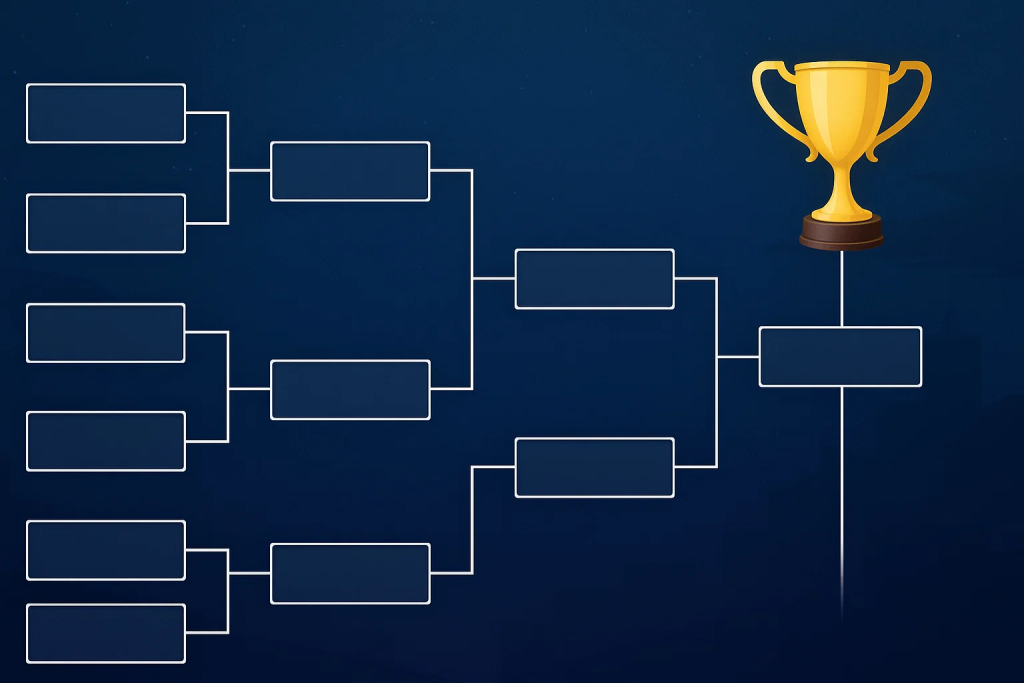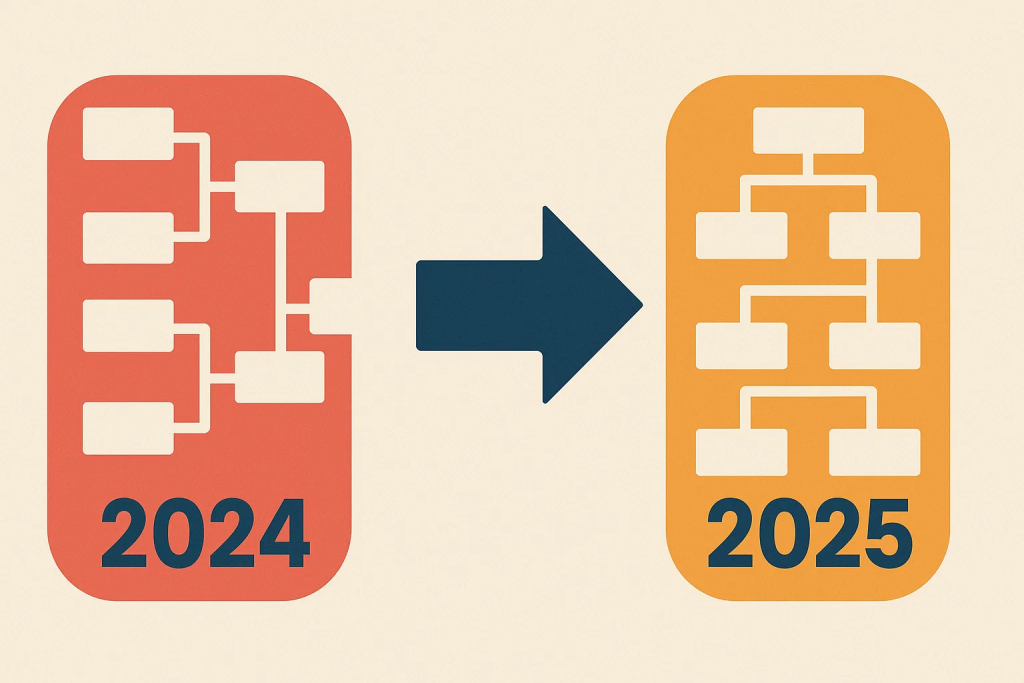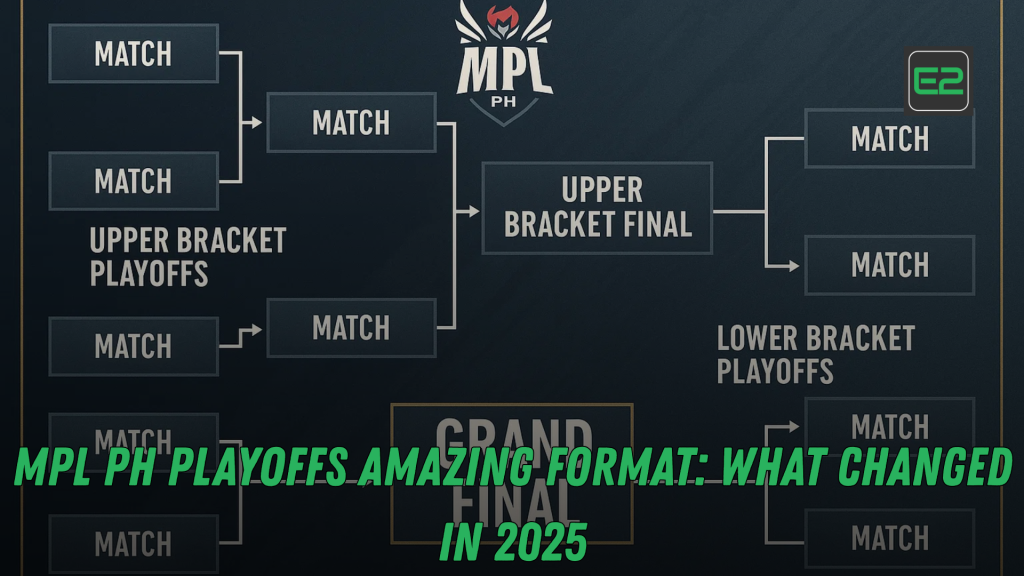Table of Contents
TL;DR (for busy fans & coaches)
- Hybrid bracket is the headline: seeds 3–6 start in a single-elimination Play-In round, while seeds 1–2 join later in a double-elimination board.
- Series lengths scale with stakes: most matches are Best-of-5, while the Lower Bracket Final and Grand Final are Best-of-7.
- Regular season matters more than ever: aiming for top two now earns valuable byes, fresher prep, and a wider draft margin for error.
- Coaching edge comes from structure: practice blocks for Play-Ins vs. Bo7 weekends, role-flex planning, and rotation-specific scouting.
- This guide includes an SEO keyword map, bracket walk-throughs, analytics that move the score, drill libraries, and ready-to-use micro-plans for both mid-seeds and top-seeds.

1) What Actually Changed in the MPL PH Playoffs 2025 Format
The 2025 MPL season locks in a format that mixes immediacy (sudden-death Play-Ins) with depth (double-elim path for top seeds and a marathon Bo7 weekend). The core shifts:
- Hybrid entry: Seeds 3–6 must survive a single-elimination opening round before joining the main double-elimination bracket.
- Protected top seeds: Seeds 1–2 skip the knockout opener and begin in the safer, more strategic double-elim phase.
- Scaled series lengths: Early to mid rounds are Bo5 to keep pace and prep sensible; the Lower Bracket Final and Grand Final elevate to Bo7 to reward draft depth, adaptation, and stamina.
- Clearer narrative for fans: A Play-In → Double-Elim → Bo7 Finals arc that is easy to follow while still creating rich, data-driven storylines for analysts and die-hards.
Bottom line: The new format rewards consistency across the season, precision under pressure in the Play-Ins, and systems-level excellence when the bracket stretches into Bo7s.
2) How the MPL Bracket Flows (Plain-English Walkthrough)
2.1 Regular Season → Seeding
Teams play a double round-robin season structured in match sets that emphasize consistency over sporadic spikes. The top six advance to the Playoffs. Finishing top two has outsized value: it confers byes past the Play-In round and starts your Playoffs in the upper bracket of the double-elim phase.
2.2 Round 1 (Play-Ins)
- Matchups: 3 vs 6 and 4 vs 5.
- Format: Single-elimination, Best-of-5.
- Stakes: Lose and you’re out. Win to enter the double-elim board.
Implications: Mid-seeds must prepare fast-start packages—reliable Level 1s, comfort picks for game ones, and contingency plans if the opponent snipes your jungle tempo.
2.3 Round 2 and Beyond (Double-Elimination)
- Entrants: Winners from the Play-Ins plus seeds 1–2.
- Format: Upper and Lower Bracket, with most series Best-of-5.
- Safety net: A single loss drops you to Lower Bracket; a second loss eliminates you.
Implications: Top seeds leverage extra prep time, while Play-In winners rely on momentum—but must manage fatigue and avoid showing their entire playbook too early.
2.4 Finals Weekend (Bo7s)
- Lower Bracket Final: Best-of-7
- Grand Final: Best-of-7
Why Bo7? It reduces randomness, enhances adaptation narratives, and ensures champions are tested across multiple drafts, tempos, and map states.
3) Why the MPL Format Matters: Strategic Incentives by Seed
3.1 Seeds 1–2 (The Bye Advantage)
- Fewer matches, deeper prep: Coaches can script likely opponents and rehearse a two-series weekend without player burnout.
- Upper bracket insulation: Early misreads don’t end your run; you can recalibrate draft approach and macro choices without facing immediate elimination.
- Information asymmetry: Scouting the Play-In winners provides fresh data on their comfort comps and emergency bans.
Coach playbook: Treat the bye like a mini-bootcamp—one script for a fast-paced opponent and one for a scaling/discipline opponent. Pre-build a Bo7 template covering phases of the series (1–2, 3–4, 5–7).
3.2 Seeds 3–6 (Win-or-Go-Home Pressure)
- Compressed margin of error: The Play-In Best-of-5 magnifies draft discipline; greedy comps without clear early insurance can sink you.
- Momentum vs. map pool: Winning the Play-In creates confidence but forces you to hide a few pocket strats or risk running dry later.
- Recovery planning: If you win Round 1, you must have a second layer ready for double-elim opponents who scouted your Play-In VODs.
Coach playbook: Build a Play-In kit (two must-win opening drafts, one curve-ball for Game 3/4, and a contingency if enemy snipe-bans you). Then build a Round-2 kit with counter-bans and role-flexes that don’t overlap heavily with the Play-In reveal.
4) Best-of-5 vs. Best-of-7: How to Draft MPL, Adapt, and Conserve
Bo5 truths:
- Front-load certainty. You cannot afford a slow start; Game 1 must be either comfort baseline or a well-rehearsed denial comp.
- Information economy. Avoid showing niche pocket picks unless you’re down 0–2; hold them for momentum swings.
- Ban arithmetic. Many Bo5s swing on second-phase bans that remove the enemy’s bridge from early pressure to late scaling.
Bo7 truths:
- Stamina beats genius. One cute comp is rarely enough; you need three or four viable win conditions.
- Act structure. Plan the series in acts:
- Act I (1–2): Establish your baseline macro.
- Act II (3–4): Change pace—flip jungle tempo, swap weak-side/strong-side.
- Act III (5–7): Bring out pocket strats or comfort mirrors; simplify calls to reduce fatigue errors.
- Counter-adaptation loop. Expect quick bans on heroes that carried Games 1–2; prepare tertiary pools and different engage/disengage tools with the same macro goal.
5) MPL Analytics That Move the Score in This Format
While Mobile Legends metrics vary by staff, the following KPI bundle maps cleanly to the 2025 format:
- First Turtle Conversion: The percentage of first turtles you secure or trade up for an equal/higher value. Signals objective discipline and ret burst layering.
- Gold/XP Lead @ 5, 8, 12: Snapshots tied to timing windows; teach whether your comp is hitting its marks or over-indexing on coin flips.
- Pick/Ban Efficiency: Kill participation and objective swing contributed by first-phase vs. second-phase picks; protects against tunnel-vision drafting.
- Teamfight Ult Sync Rate: How often your primary CC/ret tools layer within optimal windows around major objectives.
- Side-Lane Pressure Index: Percentage of waves slow-pushed or frozen intentionally; the lever that unlocks turtles or forces enemy rotations.
- Series Adaptation Score: Changes in bans, first-rotation picks, and macro calls after each loss; good teams improve this over a Bo7.
Starter pack for coaches: Track First Turtle Conversion, Gold @ 8, Pick/Ban Efficiency, and a simple Adaptation Score (0–3) after each loss. Share a one-page report with players 15 minutes after a series.
6) MPL Scouting Template: One Page, Rotation by Rotation
Keep it short and actionable:
- Opening habits: Do they leash jungle top/bot? What’s the first ward? Which duo roams first?
- Objective economy: Contest first turtle or trade plates/camps? How do they layer ultimates?
- Side-lane tendencies: Freeze points, TP timings, wave states used to mask macro swaps.
- Draft triggers: First-phase bans they cannot leave open; first-pick safety they love.
- Win conditions: Who needs gold priority? Who turns fights with one item spike?
- Play-In irregularities: If you face a mid-seed that just survived Round 1, expect them to repeat the comp that worked—ban its linchpin.
Print this for captains with three bolded bullet points: serve targets (the enemy lane you will pressure), first turtle call (contest or trade), and emergency plan (what to pick if they remove two of your core pieces).
7) MPL Draft Architecture for the New Format
- Dual-path prep:
- Path A (fast): Early dive tools, decisive engage, and ret burst for objective steals.
- Path B (slow): Two-scaler comp with disengage and strong wave control.
- Role flexibility: Teach at least one player a secondary role to unlock pocket comps that force enemy bans in Bo7.
- Second-phase traps: Save a comfort counter that punishes the opponent’s first-phase identity.
- Red side vs. Blue side scripting: Have a first-pick matrix and a counter-first-pick matrix that do not share too many heroes.
8) MPL Practice Blocks for Play-Ins vs. Bo7 Weekends
Play-Ins microcycle (mid-seeds):
- Day 1: Comfort baseline tests; gold/XP timing checks at 5/8/12; scrim two opponents with similar tempo.
- Day 2: Counter-strat day; rehearse two emergency drafts and first-turtle calls.
- Day 3: Curve-ball lab; try a role-flex map then switch back to baseline comp mid-scrim to simulate series pivots.
- Day 4: VOD day; “two clips per player” rule—one strength, one growth point.
- Day 5: Stage sim; Bo5 set with scheduled timeouts and between-map comm resets.
Bo7 weekend microcycle (top seeds):
- Day 1: Long-form pacing; run a five-map scrim block with planned pace shifts.
- Day 2: Ban flexibility; rehearse losing both first-phase comfort picks and still hitting comp goals.
- Day 3: Stamina & reset routines; practice between-map breathing and short huddles with a three-phrase system (goal, risk, focus).
- Day 4: Set-piece rehearsals; first-turtle variants, 5v5 ret burst layering, and split-push contingencies.
- Day 5: Opponent specificity; copy their three most-used opens and beat them twice in scrim.

9) Sports Science for Esports: Keeping Players Fresh
- Load management: Cap high-stress scrims two days before a Bo7. Use shorter, purpose-specific blocks.
- Vision & posture breaks: Between maps, stand up, look far, then near; roll shoulders and wrists; hydrate.
- Fueling: Steady, low-glycemic snacks; avoid late-series sugar spikes and caffeine crashes.
- Breathwork & comm clarity: Two slow exhale cycles before draft; captains enforce “one idea at a time” rules during hectic fights.
10) MPL Communication Systems that Scale from Play-Ins to Bo7
- Three-word call rules: Every macro call should fit inside three words (e.g., “trade top plates,” “force turtle now,” “reset vision here”).
- Color codes for risk: Green = low-risk trade, Yellow = calculated fight, Red = must-win.
- After-loss huddles: 45 seconds, max two adjustments; anything more increases tilt.
- Clip review: One clip per player, not five—keep cognitive load low.
11) The Fan & Broadcast Experience Under the New Format
- Narrative clarity: Viewers follow a clean arc—Play-Ins (danger), double-elim (resilience), Bo7 finals (mastery).
- Long-form catharsis: Bo7s create space for reverses, comebacks, and emotional releases; fan engagement rises with series depth.
- Scheduling cadence: Expect longer finals days; teams and fans should plan hydration, breaks, and content capture windows.
12) Brand & Sponsor Opportunities
- Predictable tentpoles: A Bo7 Grand Final is an easy-to-market main event.
- Story-driven assets: “From Play-In to champion” arcs produce strong branded content.
- Data storytelling: Share improvement metrics—objective conversion rates, adaptation scores—to highlight team professionalism.
13) Content Calendar for Playoff Month (Teams & Creators)
- Week 1: “Format explained” carousel, captains’ goals, and a behind-the-scenes mini-tour.
- Week 2: Clip explainers—how your team calls first turtle, why you picked certain bans.
- Week 3: Micro-stories on role-flexes, scrim day rituals, and comm systems.
- Finals week: Daily recap shorts, two POVs (coach and jungler), celebratory content plans for both outcomes.
14) Troubleshooting: If Your Plan Isn’t Working
- 0–2 start in a Bo5? Time-out, remove variance from draft, and pick the comp with the cleanest objective plans; accept fewer kills if it stabilizes macro.
- Targeted bans hit your comfort picks? Switch to a win condition that uses the same wave-control principles with different heroes.
- Turtle losses pile up? Trade decisively—secure cross-map plates and camps; do not “half-contest.”
- Mental tilt after a throw? Short huddle: acknowledge error, lock next call (“contest or trade”), and reaffirm your color-code risk for the next objective.
15) Two Ready-to-Use 7-Day Micro-Plans
15.1 For Seeds 3–6 (Play-Ins First)
Day 1 — Comfort Baseline
- Two scrim sets; verify execution of your safest openers.
- KPI: Gold @ 8 within comp targets; First Turtle Conversion ≥ planned threshold.
Day 2 — Counter Day
- Practice two enemy-first drafts; deny their tempo and test your disengage.
- KPI: Objective trades when you cede turtle.
Day 3 — Curve-Ball Lab
- Role-flex once; test a surprise pick reserved for Game 3.
- KPI: Communication clarity after swaps.
Day 4 — VOD & Quiz
- 45 minutes: five clips, one quiz on enemy objective setups.
- KPI: Right answers ≥ 80%.
Day 5 — Stage Sim Bo5
- Enforce time-outs; practice between-map resets.
- KPI: Adaptation Score improves after each loss.
Day 6 — Light Tune-Up
- Short scrims, no new strats; review first 10 minutes of all maps.
- KPI: Clean early game flow.
Day 7 — Match Day
- Pre-map mantra: goal, risk color, focus.
- KPI: Execute the plan; no last-minute hero experiments.
15.2 For Seeds 1–2 (Bye into Double-Elim)
Day 1 — Opponent Profiles
- Build one-page scouting sheets; define serve targets and emergency picks.
Day 2 — Long-Form Pace
- Run a four-map block; shift tempo intentionally on Map 3.
Day 3 — Ban Flexibility
- Practice losing two favorite bans and still reaching win-cons.
Day 4 — Objective Scripts
- First-turtle variants, vision plans, and split-push calls.
Day 5 — Bo7 Skeleton
- Test Act I/II/III draft outlines; slot in two curve-balls.
Day 6 — Recovery & Review
- Minimal scrim, heavy comms reset; finalize call sheets.
Day 7 — Match Day
- Maintain routines; protect energy for possible five-map and seven-map days.
16) Do’s & Don’ts for the 2025 Playoffs
Do
- Prioritize top-two regular-season finish for byes.
- Script two pathways (fast and slow comps) and teach role-flexes.
- Track First Turtle Conversion, Gold @ 8, and an Adaptation Score.
- Use short, specific time-out language tied to objective calls.
Don’t
- Over-reveal pocket picks in Play-Ins unless necessary.
- Chase kills when the trade map is open.
- Add five new ideas between maps; add one.
- Ignore player stamina—Bo7s punish sloppy posture, hydration, and screen fatigue.

Strong Call-to-Action
Coaches, captains, and analysts: Drop your team level (school, club, franchise), your biggest 2025 pain point (e.g., “we stall in Play-Ins,” “we fade in Game 6”), and how many practice blocks you can run next week. I’ll reply with a custom 7-day Playoffs micro-plan—including two Play-In scripts, a double-elim counter layer, and a Bo7 act outline you can adopt immediately. If you’re a fan or creator, share your favorite Play-In upset or Grand Final comeback moment and what you learned about the format. Let’s turn the Amazing Format into amazing performances.
Frequently Asked Questions (FAQ)
1) What is the MPL PH Playoffs 2025 format in simple terms?
It’s a hybrid format. Seeds 3–6 begin in a single-elimination Play-In round played as Best-of-5 series. Seeds 1–2 receive byes and enter the next phase, which is double-elimination. Most matches remain Best-of-5, while the Lower Bracket Final and Grand Final are Best-of-7 to reward depth, adaptation, and stamina.
2) Why are byes for the top two seeds so valuable?
Byes remove the risk of a sudden early exit, reduce match volume, and create extra prep time. Top seeds can scout Play-In winners, preserve pocket strategies for later rounds, and manage player health for longer series—advantages that compound in a season shaped by Bo5 and Bo7 matches.
3) How should mid-seeds prepare for the Play-Ins?
Focus on a fast-start kit: two reliable opening drafts, one curve-ball for momentum swings, and a contingency if the opponent targets your comfort picks. Practice first-turtle calls, trade discipline, and between-map resets. Winning the Play-In is about reducing variance and forcing the opponent into your pacing.
4) What’s the biggest difference between Bo5 and Bo7 prep?
In Bo5, front-load certainty and maintain information economy; do not over-disclose pocket picks. In Bo7, plan the series in acts with multiple viable win conditions, tertiary hero pools, and pre-scripted tempo shifts. Bo7s prioritize systems (communication, stamina, adaptation) over one-off clever drafts.
5) Which analytics are most useful for this format?
Start with First Turtle Conversion, Gold or XP at minute 5/8/12, Pick/Ban Efficiency, Teamfight Ult Sync Rate, and a simple Series Adaptation Score after each loss. These indicators anchor your draft choices, inform trade decisions, and reveal whether your team is improving within a series.

